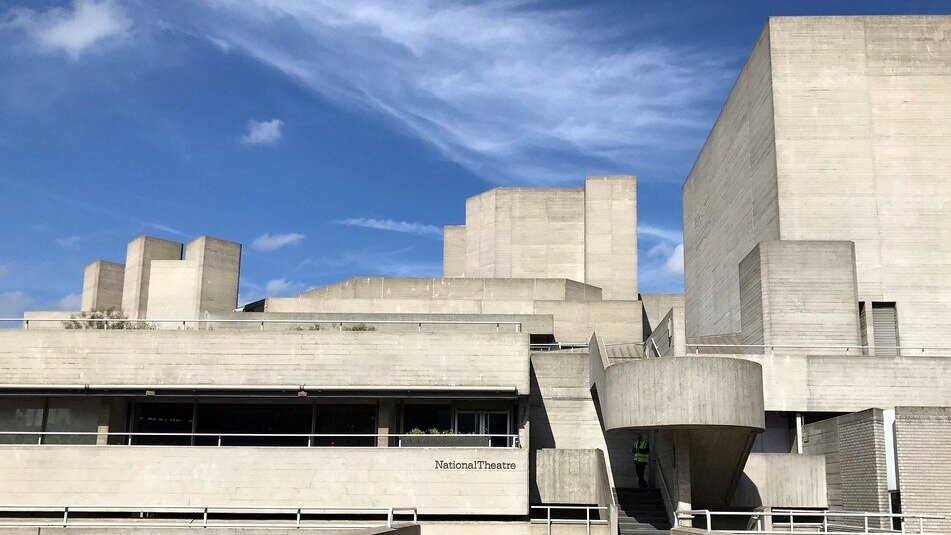
The architecture of St Paul’s Church, Bow Common
Overview
General features
In form, the building is basically a stack of three diminishing cubes with ancillary spaces added at the sides. Maguire and Murray’s defining geometry was that of two bounded areas – contained by the exterior and barely broken bounding walls and also by the inner ‘transparent’ encircling line of columns.
These columns surround the worshipping area around the altar, and outside the columns are areas serving the varying needs of the Christian community – a space in which the whole common life of the worshipping community could be lived out – and from which they would then go out into the world.
Benches were designed to be easily moveable so that they could be set aside or re‐arranged according to need.
The roots and antecedents of this building’s design run deep; to classical forms and the Renaissance Revival, to the fundamental geometry of square and circle, influences owing a debt to Brunelleschi, Palladio, Bramant, and further back, to the churches of Torcello, to Hagia Sophia in Constantinople and to the great Pantheon in Rome.
‘St Paul’s Church, Bow Common’
Photo: stevecadman is licensed with CC BY-NC-SA 2.0
Why it’s significant
St Paul’s Bow Common by Robert Maguire and Keith Murray (1959-60) is a post-war church of great significance and is the vanguard of the Liturgical Movement in the Anglican Church.
In 2013 this was recognised when it was awarded the best post-1953 church in Britain, following a competition held by the National Churches Trust / Ecclesiastical Architects and Surveyors Association / The C20 Society on the occasion of the 60th anniversary of the National Churches Trust.
St Paul’s Bow Common was the project that launched the practice of Robert Maguire and designer-craftsman Keith Murray, and together they would go on to conceive a remarkable series of churches and other religious buildings including St Matthew’s Church, Perry Beeches, Birmingham, All Saints, Crewe in Cheshire and St Mary’s Abbey Church, West Malling, Kent.
Not only did Maguire and Murray completely re-think the design of churches, but they also are credited with reinventing the typology of both school buildings and student accommodation, with significant projects including the Bow Common Primary School (adjacent to St Paul’s Church) and Stag Hill Court student houses. Though small, the design-led practice was highly influential within the changing context of post-war architecture in the UK. Their reputation developed for pursuing the intellectual and architectural toughness of the style known as New Brutalism with the humanity and warmth of the Scandinavian tradition Maguire and Murray were deeply engaged in the New Churches Research Group, through which the Liturgical Movement, originating in Europe between the wars, arrived in England with significant impact and changed the manner of worship in the post-war era.
The design for St Paul’s Church at Bow Common is considered to be one of the first full and authentic expressions of the ideas of the Liturgical Movement which sought to place the High Altar centrally within the worship space and to break down perceived or physical barriers between the celebrant of the Eucharist and the worshipping community. An inclusive, more participatory liturgy and inherent flexibility in how the bench seating could be arranged were key aspects of the Brief for the new church which was inspired by the Vicar, Rev Gresham Kirkby.
In response to this, Maguire and Murray sought to conceive an appropriate modern setting for worship and Maguire, in particular, looked to the centrally planned churches by Rudolf Schwarz in Rhineland and also the symbolism of the centralised church plans of Renaissance Italy and Rudolf Wittkower’s rediscovery of the sacred meaning of their geometry.
Despite the dominance of the centralised plan at St Paul’s, the conception of the space includes a rich layering of ideas. Whilst the principal axis extends from the ceremonial west doors through to the articulated Chapel of the Blessed Sacrament, the alternative route through the octagonal Porch (where one enters beneath Ralph Beyer’s recessed lettering which proclaims ‘… This is the Gate of Heaven’) delivers one from darkness into light, symbolically moving past the baptismal font positioned at the intersection of the northern and western processional routes within the perimeter aisles. This route is set beneath the relatively low, reinforced concrete roof slab which concertinas on all sides of the church to create intermittent triangular glazed gables above the perimeter brickwork walls. These do allow a degree of daylight into the interior, but the aisles remain dimly lit in contrast to the central worship space which is flooded with daylight from the diamond-shaped lantern which is glazed on all four sides such that the incredibly fine roof structure appears to float above the principal cubic volume of the church.
The simple but bold tectonic expression is created through a simple palette of materials and authenticity in construction – in stock bricks and fair-faced concrete – which embodies the spirit of sacramentalism, that is, ordinary things made special through a transformative process, in this case, inspired design.
In his recent Monograph about the work of Bob Maguire and Keith Murray, Gerald Adler suggests Bow Common is “the most famous and significant parish church to be built in Britain in the latter half of the twentieth century. It crystallised architectural and theological thinking about the form that the church should assume in the post-war era. It was a highly symbolic project, the one which would bring the practice critical acclaim.”
View of St Paul's Bow Common shortly after completion in 1960
© The Architectural Review: Volume CXXVIII No 766 Dec 1960; pp 401-5
Repairs & projects
2014: An urgent repair project was conceived as a direct response to the partial collapse of the ceiling linings to the lantern over the central High Altar, which occurred on a very hot July day in 2013.
2015—16: Essential repairs, supported by a very generous grant from the Heritage Lottery Fund. Thanks to National Lottery players, we were able to replace our remarkable ceiling, make the church waterproof and revive tired concrete surfaces.
2020—21: Essential repairs were carried out to the West Doors and Porch Doors of the church. This included restoration and resurfacing of the original solid wood. These works were supported by the Heritage Lottery Fund.
Architects
Keith Murray (1929—2005)
Keith Murray trained at the Central School of Art in London, becoming a distinguished silversmith and designer of textiles and embroidery.
He joined Watts & Co (the leading ecclesiastical outfitters at the time) just in time to create the cope for Archbishop Geoffrey Fisher at the coronation of the Queen in 1953, a design remembered for its beautifully elongated lions and unicorns.
In 1954 he was commissioned to work with the silversmith Michael Murray (no relation), the letter carver Ralph Beyer and the architect Robert Maguire to design the layout and fittings of the new chapel of the Royal Foundation of St Katherine in Stepney, east London. So began the breakthrough in postwar church design in which Maguire and Murray in partnership were pioneers.
In 1956, their first church was St Paul's, Bow Common, east London. The central position of the altar was then a striking new feature, and the economy of the design, together with the use of industrial materials (the font was of concrete inset with copper), contrasted with the new Coventry Cathedral, which Murray and Maguire regarded as essentially medieval in concept.
“...The buildings Murray helped create prove to be of timeless quality, a gift to the modern world, conscious of threats to the environment. In their modesty and economy of scale they touch people truly, serving their needs at every level.”
Robert Maguire (1931—2019)
Robert Maguire was a leading light in the liturgical reform movement within the Church of England. The partnership of Maguire and Murray stood for the best in British architectural practice in the mid to late-20th century and made outstanding and original contributions to design culture. Buildings for religious practice, for education and for student living formed the particular locus of invention in terms of building type.
Robert met Keith, while the latter was still working at Watts & Co. The two men became instant friends, not least because of their passionate interest in Christianity, especially of the reforming variety. They soon became core members of the New Churches Reform Group, centred on the groundbreaking ideas of the theologian Peter Hammond.
“I designed the building as ‘liturgical space’, informed by how I saw the nature of liturgy as the formative activity in realising the community as the Body of Christ. Now I would call it ‘inclusive space’, a space that enables everyone within it, wherever they are, to feel included in what is happening, wherever in the space that may be.”
Brutalism
The Church’s architecture is often referred to as New Brutalist.
Brutalism is a movement in architecture that flourished from the 1950s to the mid-1970s. The term originates from the French word for ‘raw’ in the term used by Le Corbusier to describe his choice of material béton brut (raw concrete).
Examples are typically fortress-like, with a predominance of exposed concrete construction, and in the case of the ‘brick brutalists’, ruggedly combine detailed brickwork and concrete.
There is often an emphasis on expressing in the whole-site architectural plan the main functions and people-flows of the buildings and creating an architectural image that communicates strength, functionality, and frank expression of materiality.
The National Theatre in London – an example of 'Brutalist architecture’
Photo: Bex.Walton, licensed with CC BY 2.0





